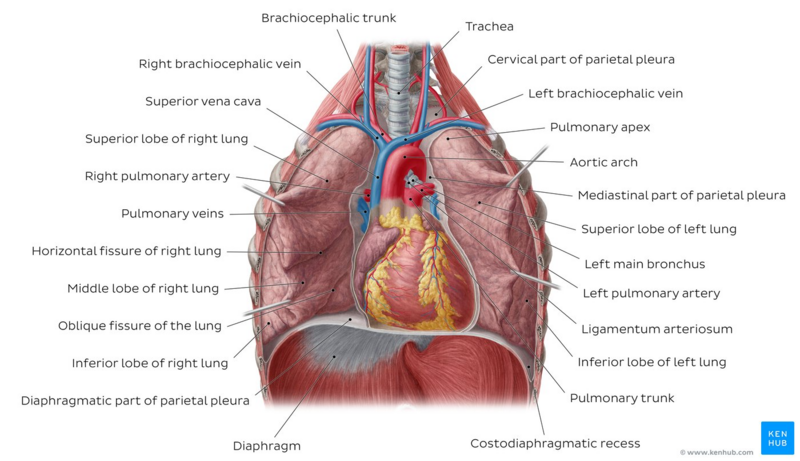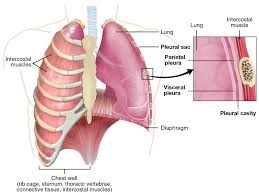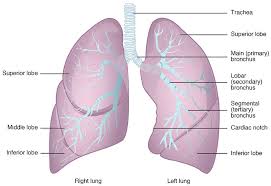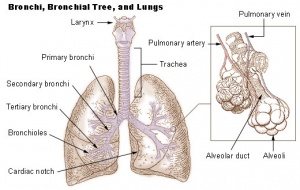Lung Anatomy
Original Editor - Uchechukwu Chukwuemeka Top Contributors - Uchechukwu Chukwuemeka, Kim Jackson, Sehriban Ozmen, Rachael Lowe, Sai Kripa, Laura Ritchie, Lucinda hampton, Evan Thomas, George Prudden, Vidya Acharya and Joao Costa
Introduction and Location[edit | edit source]
The lungs, which is the organ for respiration is a paired cone shaped organs lying in the thoracic cavity separated from each other by the heart and other structures in the mediastinum.
Image: Lungs in situ - anterior view [1]
- Each lung has a base resting on the diaphragm and an apex extending superiorly to a point approximately 2.5 cm superior to the clavicle[2]. It also has a medial surface and with three borders- anterior, posterior and inferior. The broad coastal surface of the lungs is pressed against the rib cage, while the smaller mediastinal surface faces medially. The lungs receive the bronchus, blood vessels, lymphatic vessels and nerves through a slit in the mediastinal surface called the hilum, and the structures entering the hilum constitute the lungs root[3].
- The right lung is larger and weighs more than the left lung[4][3]. Since the heart tilts to the left, the left lung is smaller than the right and has an indentation called the cardiac impression to accommodate the heart. This indentation shapes the inferior and anterior parts of the superior lobe into a thin tongue-like process called the lingual.[3]
Pleura[edit | edit source]
Each lung is invested by and enclosed in a serous pleural sac that consists of two continuous membranes.
- The visceral or pulmonary pleura invest the lungs,
- The parietal pleura line the pulmonary cavities and adhere to the thoracic wall, mediastinum and diaphragm.
- The parietal pleura consists of four parts: coastal pleura which lines the internal surface of the thoracic wall, mediastinal pleura which lines the lateral aspect of the mediastinum, diaphragmatic pleura which lines the superior surface of the diaphragm on each side of the mediastinum, cervical pleura extends through the superior thoracic aperture into the root of the neck, forming a cup-shaped dome over the apex of the lung[3].
Pleural Cavity[edit | edit source]
- The pleural cavity is the potential space between the visceral and parietal layers of the pleural and it contains a capillary layer of serous pleural fluid which lubricates the pleural surfaces and allows the layers to slide smoothly over each other during respiration. Surface tension created by the pleural cavity provides the cohesion that keeps the lung surface in contact with the thoracic wall[2].
The video below includes a detailed anatomy and physiology of the pleura and its cavity.
Lobes and Fissures of the Lungs[edit | edit source]
Each lung is divided into lobes by fissures.
- Both lungs have oblique fissures and the right is further divided by a transverse fissure. The oblique fissure in the left lung separates the superior and the inferior lobes. The oblique and horizontal fissure divides the lungs into superior, middle and inferior lobes. Thus the right lung has three lobes while the left has two.
- Each lobe is supplied by a lobar bronchus. The lobes are subdivided by bronchopulmonary segments which are supplied by the segmental bronchi.[6]
The video below is a useful introduction to the topic where lung anatomy is explained on 3D models.
Tracheobronchial Tree[edit | edit source]
All the respiratory passages from the trachea to the respiratory bronchioles are called the tracheobronchial tree[2][3][4]. The trachea divides at the sternal angle into the right and left primary bronchus which goes into the right and left lungs. Each bronchus enters the lung at a notch called the hilum. Blood vessels and nerves also connect with the lungs here and together with the bronchus form a region called the root of the lungs.
The right main bronchus is larger in diameter and more vertical making it directly in line with the trachea than the left main bronchus[3]. Thus swallowed objects that accidentally enter the lower respiratory tract are most likely to become lodged in the right main bronchus[8].
The main bronchi divide into lobar or secondary bronchi within each lung. Two lobar bronchi exist in the left lung, and three exist in the right lung. The lobar bronchi, in turn, give rise to segmental or tertiary bronchi. The tertiary bronchi supply the bronchopulmonary segments.
Bronchopulmonary Segment[edit | edit source]
Functionally, the lung is divided into a series of bronchopulmonary segments. The bronchopulmonary segments are the largest subdivision of a lobe. They are separated from adjacent segments by connective tissue septa and are also surgically resectable. They are 10 bronchopulmonary segments in the left lung and 8-10 in the left lung[9].
The bronchi further divides, finally giving rise to the bronchioles which are less than 1mm in diameter. Each bronchioles divides into 50 to 80 terminal bronchioles, the final branches of respiratory bronchioles. The functional unit of the lungs which is the acinus includes the respiratory bronchioles, alveolar ducts, and sacs and the alveolar[2]. Approximately 16 generations of branching occur from the trachea to the terminal bronchioles[2]. As the air passageways of the lungs become smaller, the structure of their walls changes[4].
Histology of Bronchopulmonary Segment[edit | edit source]
The major airways from the trachea through the ten generations of bronchi have descending amounts of cartilaginous support surrounded by smooth muscles and elastic fibres, they have goblet cells for mucus production and are lined with ciliated columnar epithelium. Sputum is not saliva but the thick mucus (sometimes called phlegm) which is coughed up from the lungs. secretion clearance.[9]
The next five generations of bronchioles have no cartilage or goblet cells but still have elastic tissue and smooth muscle fibres. They are lined with ciliated cuboidal epithelium. Relaxation and contraction of the smooth muscles of the bronchi and bronchioles can change the diameter of the air passageways and so change the volume of air moving through them. The alveoli provide a large surface area for gas exchange. The alveolar walls consist of simple squamous epithelium. Also, the tissues surrounding the alveoli contain elastic fibres which allow the alveoli to expand during inspiration and recoil during expiration.[9]
The epithelium of the respiratory zone is not ciliated but debris from the air can be removed by macrophages that move over the surface of the cells. Approximately 300 million alveoli are in the lungs. The average diameter of the alveoli is approximately 250um and their walls are extremely thin. There are two types of cells in the alveoli: type I pneumocytes which are thin squamous epithelia cells that form 90% of the alveoli surface. Most of the gas exchange takes place between these cells. Type II pneumocytes are round secretory that produce surfactant, which makes it easier for the alveoli to expand during inspiration[9].
Blood Supply[edit | edit source]
The bronchial arteries arising from the aorta provide blood supply to the non-respiratory airways, pleura, and connective tissue while the pulmonary arteries supply the respiratory units (acini) and participate in gas exchange.[3][4]
Venous drainage is mainly by the pulmonary veins (right and left superior and inferior pulmonary veins), though the venous drainage from the walls of the larger bronchi is carried out by the bronchial veins. All four veins (pulmonary veins) drain into the left atrium.[3][4]
Nerves Supply[edit | edit source]
The lungs and airways are innervated by the branches of the sympathetic trunk and vagus nerve[3]. Sympathetic nervous stimulation results in bronchodilation and slight vasoconstriction, while parasympathetic nervous system stimulation results in bronchoconstriction and indirect vasodilation. The function of the lungs is controlled through the respiratory centre with groups of neurons located at the pons and the medulla oblongata and complex interactions of specialized peripheral central chemoreceptors.[4]
Relevance to Physiotherapy[edit | edit source]
Auscultation of the lungs and percussion of the thorax are important techniques used during physical examination. Auscultation assesses airflow through the tracheobronchial tree into the lungs.
Percussion helps establish whether the underlining tissues are air-filled (resonant sound), fluid-filled (dull sound) or solid (flat sound).
Based on the anatomy of the bronchial tree, gravity can be used to assist in the clearance of bronchial secretions through the use of positioning. Also, Bronchial disorders such as tumours and abscesses may be localized in a bronchopulmonary segments and may be surgically removed without disrupting the surrounding lung tissue.[4][8]
Defences of the Lungs[edit | edit source]
There are a number of structures that protect the lungs from inhaled organisms and particles:
- Nasal mucosa and hairs: warm and humidify inhaled air and filter out particles.
- Goblet cell and bronchial seromucous glands: produce mucous which contain immunoglobulin A, cytokines, and other cytolytic substances, with extensive mucosal production of nitric oxide by the nose and paranasal sinuses; all of these have potent antimicrobial activity, to protect underlining tissues and trap organisms and particles. Bacteria are destroyed by lysozyme in the mucus. Also, additional protection against bacteria is contributed by lymphocytes which populate the lamina propria in large numbers. The lamina propria contains large blood vessels that help to warm the air.[10]
- Furthermore, the inferior concha has an especially large venous plexus called the erectile tissue. Every 30 to 60 minutes, the erectile tissue on one side becomes engorged and restricts airflow through that fossa, causing air to be redirected through the other nostrils and fossa thus allowing the engorged side to time to recover from drying. The flow of air shifts between the right and the left nostrils once or twice each hour. Mucous production is increased by inflammation (e.g. in conditions like asthma and bronchitis) and its composition can be altered by diseases.[10]
- Cilia: structures move the nucleus up the carina and the throat through mucociliary transport. Mucociliary transport is impaired by inhalation of toxic gases (e,g cigarette smoke and air pollution), acute inflammation, infection, anaesthesia, etc[10].
- Type II pneumocytes: produces surfactant which protects underlining tissue and repairs damaged alveoli epithelium.
- Alveoli macrophages: engulfs foreign matter and bacteria. Their activity can be hindered by cigarette smoke, air pollution, alveolar hypoxia, radiation, corticosteroid therapy, and ingestion of alcohol.
- B lymphocytes: produce gamma globulin for the production of antibodies to resist infections.
- Polymorphonuclear leukocytes engulf and kill blood-borne gram-negative organisms.[10]
Gaseous Exchange[edit | edit source]
The pharynx, or throat, receives air through the mouth or nose and immediately passes to the pharynx. It then enters the trachea after passing through the larynx, or voice box. The trachea is a robust tube that is protected from collapsing by cartilage rings. The trachea splits into the left and right bronchus within the lungs. These are further divided into bronchioles, which are smaller branches. The bronchioles that are the smallest end in tiny air sacs. These are referred to as alveoli. When a person inhales, they expand, and when they exhale, they deflate. Oxygen is transferred from the lungs to the bloodstream during gas exchange. Carbon dioxide is transported from the bloodstream to the lungs at the same moment. This occurs in the lungs, between the alveoli and a network of microscopic blood arteries known as capillaries, which are found in the alveoli's walls. Red blood cells are seen passing through capillaries. The alveolar walls and capillary walls share a membrane. This allows oxygen and carbon dioxide to readily pass from the respiratory system to the bloodstream. Oxygen molecules bind to red blood cells as they return to the heart. At the same time, when a person exhales, the carbon dioxide molecules in the alveoli are blown out of the body. The body uses gas exchange to replenish oxygen and remove carbon dioxide. It is vital to do both in order to survive.[6]
Resources[edit | edit source]
References[edit | edit source]
- ↑ Lungs in situ image - © Kenhub https://www.kenhub.com/en/library/anatomy/the-lung
- ↑ 2.0 2.1 2.2 2.3 2.4 Scanlon, VC, anders, T. Essentials of anatomy and physiology. 6th eds. F.A. Davis. Philadelphia, 2011
- ↑ 3.0 3.1 3.2 3.3 3.4 3.5 3.6 3.7 3.8 Drake, RL, Vogl, W, Mitchell, AW, Gray, H. Gray's anatomy for Students 2nd ed. Philadelphia : Churchill Livingstone/Elsevier, 2010.
- ↑ 4.0 4.1 4.2 4.3 4.4 4.5 4.6 Moore, KL, Dalley, AF, Agur, AM. Clinically oriented anatomy. 7th ed. Baltimore, MD: Lippincott Williams & Wilkins, 2014
- ↑ Armando Hasudungan. Lung Pleura - Clinical Anatomy and Physiology. Available from: https://www.youtube.com/watch?app=desktop&v=qiZrjs8c2Ck
- ↑ 6.0 6.1 Chaurasia BD. Human Anatomy Regional and Applied Dissection and Clinical. Vol 1. CBS Publishers and Distributors Pvt Ltd, 2010
- ↑ Sam Webster. Lungs (anatomy). Available from: https://www.youtube.com/watch?v=_RhUBoM85vo
- ↑ 8.0 8.1 Watchie, J. Cardiovascular and pulmonary physical therapy. A Clinical manual. 2nd eds. Saunders Elservier, 2010
- ↑ 9.0 9.1 9.2 9.3 Seeley, RR, Stephens, TD, Tate, P. Essentials of anatomy and physiology. 6th eds. Mc Graw-Hill, 2006
- ↑ 10.0 10.1 10.2 10.3 Gaga, M, Viginola, AM, Chanez, P. Upper and lower airways: similarities and differences. European Respiratory Journal. 2001; 18: 1-15.
- ↑ Lungs anatomy video - © Kenhub https://www.kenhub.com/en/library/anatomy/the-lung










